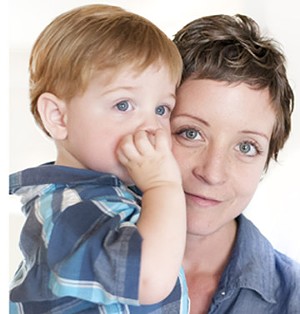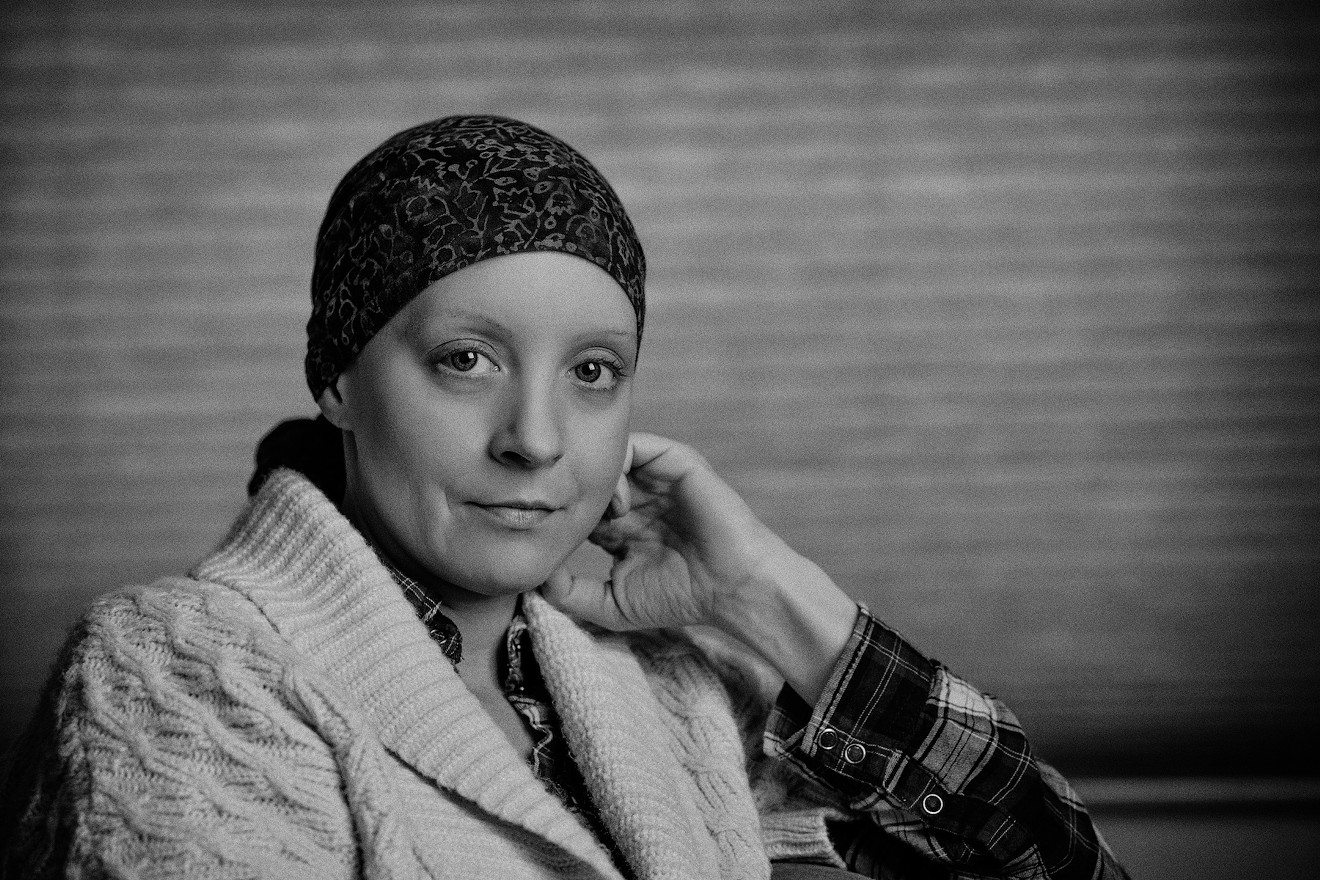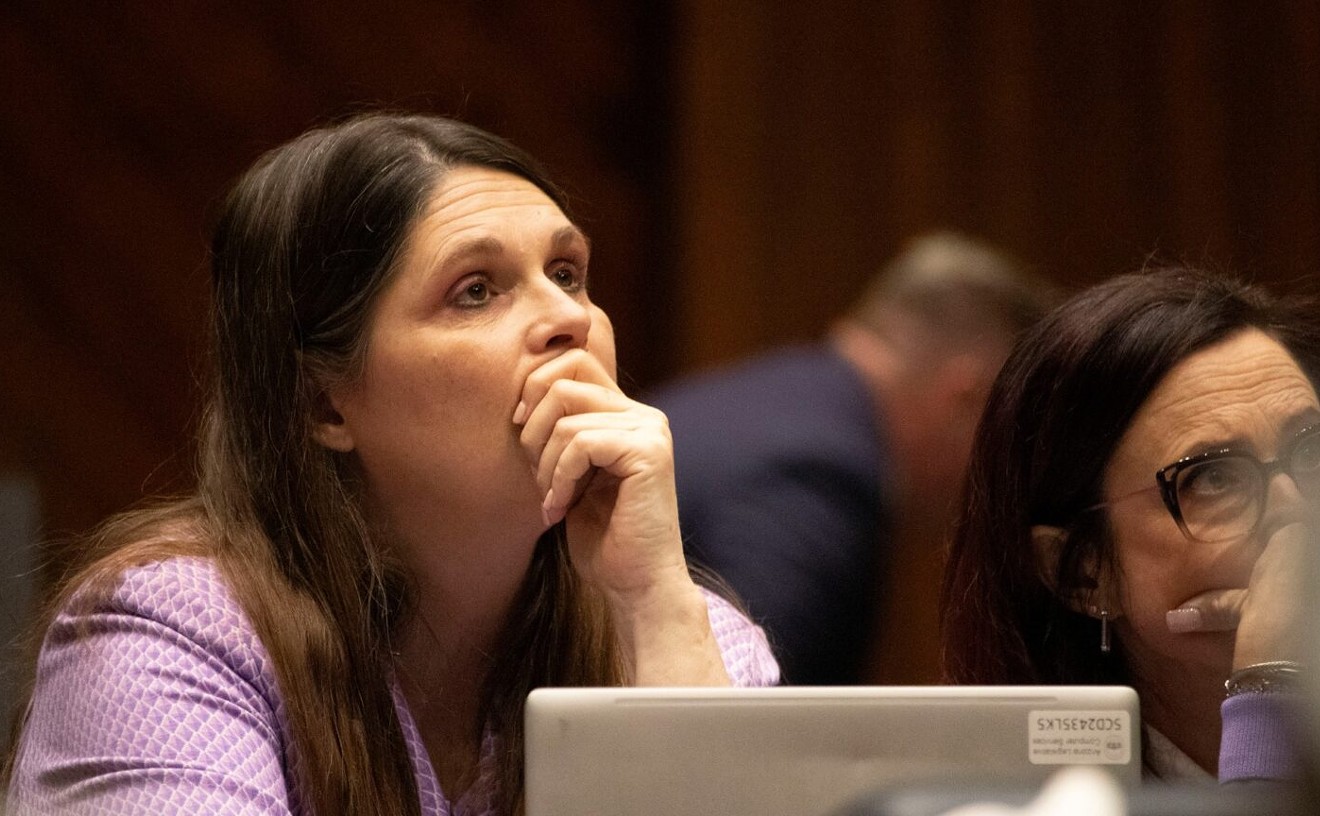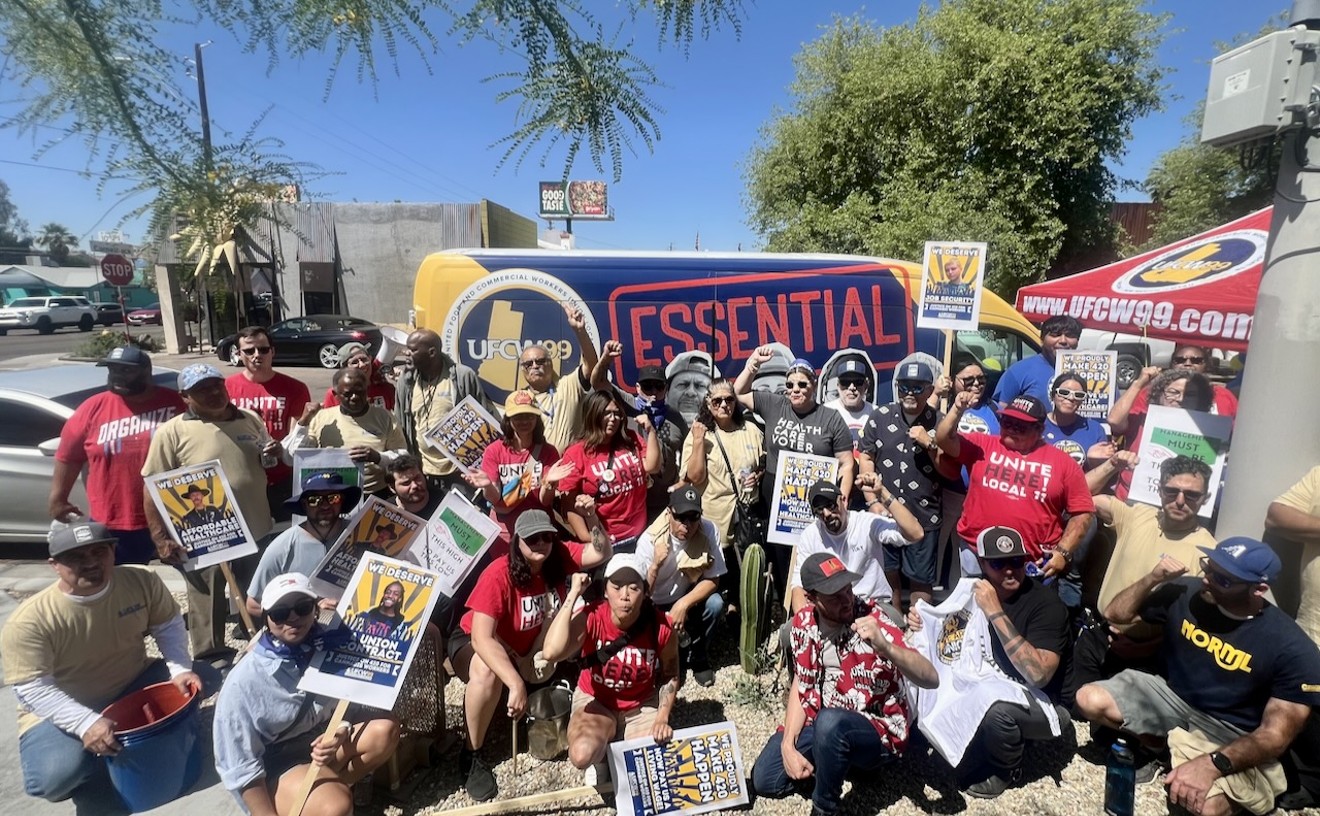Komen Arizona shut its doors this summer and left the 4,870 Arizona women who are likely to be diagnosed with breast cancer this year to find a different race.
For some of them, this will really hurt. It may mean they turn to a smaller nonprofit for help paying for their treatment. It may mean they don’t get treatment at all.
For the estimated 154,794 women nationally who live on the fringe of this pink-ribbon lifestyle, Komen’s exit is less of a gut punch and more of a light shove. These women were never part of this narrative, anyway.
They are not the cheerful faces crossing the finish line or proudly wearing the badge of survivor.
They are Stage Four.
Cancer isn’t a battle for them — it’s a war.
A war Jen Campisano, a Phoenix resident, thought she had no chance of winning.
In her 20s, she ran the 3.1 miles for the cure.
She did it for the T-shirt and because her Johns Hopkins University cross country team was participating. She thought raising money through Komen would help grandmothers like her own who was diagnosed with the disease.
Ten years, a husband, and a move across the country later, she didn’t know she would be on the other side of the pink finish line.
She didn’t know women could be diagnosed with breast cancer at age 32.
She didn’t know that her diagnosis in 2011 would alter her life.
“Once I was diagnosed and I realized they were still talking about awareness, then I was like, ‘Who doesn’t know about breast cancer?’” Campisano said. “Awareness is not what we need.”
The Susan G. Komen Foundation was created in 1982 by Nancy Brinker to honor her sister, Suzy, who died of breast cancer two years earlier. The foundation was built around a sister’s promise to end breast cancer forever.
Today, the Komen network stretches to 60 countries and often is the name most associated with breast cancer awareness.
After coming under fire for its policies and politics, the nonprofit has undergone a massive downsizing, which it attributes largely to a decrease in donations and participants in its Race for the Cure and 3-Day events.
However, Komen’s focus on awareness and education, rather than research, has left advocacy groups like Breast Cancer Action frustrated.
Awareness and education is one piece to a much more complicated puzzle, said Karuna Jaggar, Breast Cancer Action’s executive director.
“The true complexity is not part of the mainstream movement, and that is a disservice to women,” Jaggar said. “It makes it harder for women to make informed decisions based on the actual evidence.”
The term breast cancer is often used as a catchall for any mutated cell that seems to have a mind of its own.
In reality, there are 21 histological subtypes and four molecular subtypes, according to the American Cancer Society.
This means not all patients are having the same experience — far from it.
The National Cancer Institute, the federal government’s principal agency for cancer research and training, spent $543.7 million dollars on breast cancer research in 2015.
Only an estimated 2 to 5 percent of all breast cancer research is dedicated to metastatic breast cancer, according to METAvivor, an organization that exclusively funds metastatic breast cancer research.
What all these numbers translate to is a simple fact — Stage Four patients are being left behind.
Breast Cancer Action works as a watchdog in the nonprofit world. It hunts down where each dollar is spent and encourages women to “Think before you pink.”
The group’s officials are not impressed with Komen.
“Komen has excelled as a marketing machine, but that has sometimes been at the expense of important information. You know, evidence. Facts,” Jaggar said.
Jaggar will say this about Komen:
They’re good at marketing — the pink ribbon was given out at a Race for the Cure event in New York City in 1991 and has been attached to the cause and the brand ever since.
They’re good at rallying women — the 2012 annual report boasted a network of 400,000 advocates.
They’re good at fundraising — more than $2.9 billion has been raised by the nonprofit since it was founded in 1982.
But, Jaggar asks, at what cost?
“Think about all of the money that has been spent on breast cancer awareness, yet you don’t know basic facts about breast cancer,” she said.
Neither representatives from Komen Arizona or the national headquarters responded to requests for comment.
But Campisano had plenty to say.
Five months after she gave birth to her little boy in 2011, Jen Campisano was diagnosed with breast cancer.
She felt a lump in her right breast and questioned her doctor about it. He concluded it was most likely a cyst or a blocked milk duct from nursing. To be on the safe side, he sent her to “the best surgeon I know” to get it checked out.
A quick exam turned into a mammogram, which turned into an ultrasound. Suddenly more and more technicians were getting involved and the pink pamphlets she saw in each room became more daunting.
Then Campisano heard the words: “This looks like cancer.”
She drove the two miles home to tell her husband, Chris, who had just recently lost his father to pancreatic cancer. They wept.
“I can’t believe we’re fucking having this conversation,” her husband said.
They spent the weekend Googling. Early detection in young women showed positive signs of survival.
That Monday morning, doctors took 15 painful tissue samples from Campisano’s breast. The tumor was 4.5 centimeters, roughly the size of a golf ball.
She was diagnosed with HER2-positive, a subtype that spreads quickly but has an effective targeted treatment and hopeful survival rates.

Campisano's son, Quinn, was only 5 months old when she was diagnosed with Stage Four breast cancer.
Courtesy of Jen Campisano
She was metastatic.
The Metastatic Breast Cancer Network estimates an average three-year survival rate.
These rates vary case-by-case and are largely determined by subtype. For HER2-positive patients like Campisano, the outlook is usually five years.
Campisano optimistically set her benchmark a little higher based on the other patients she befriended.
She mentally mapped out her cancer journey parallel to her son, Quinn’s, life.
“I thought, ‘Well if I can make it seven or eight years, then they’ll have so much more available at that time and maybe it’ll shift to 10 or 12 years,’” she said. “Maybe we can get to high school.”
Both motherhood and metastatic breast cancer were uncharted territory, and the intersection of the two left her without a map entirely.
After her first round of chemo, 6-month-old Quinn reached up and grabbed Campisano’s hair, pulling her in for a big sloppy kiss. When he released, he was left with a clump of her brunette locks.
Two weeks later, she shaved her head bald. First hurdle cleared.
“I didn’t think, in the beginning, of Stage Four cancer as something you carry with you for a long time,” Campisano said. “Even as bad as the statistics were, I was thinking it was something I could knock out and then be done with. I think that just speaks to how naïve I was about it.”
Every third Friday, chemo was administered into the port surgically implanted above her breast.
The following Saturdays she would receive a shot of Neulasta to boost her white blood-cell count. If insurance hadn’t covered it, each shot would have cost $6,000.
The treatment was working. She could feel the tumor shrinking. Her December scan was clear, an early Christmas present.
In January 2012 she decided to get a double mastectomy, with plans for reconstructive surgery.
She proceeded with radiation in March for five weeks. This meant some days Quinn would have to stay longer at preschool or daycare until his mom was safe to hug.
That July, she returned for another scan and received familiar news — there were spots in her chest wall and spleen again.
Not even a year had passed since her original diagnosis and Campisano was preparing for another six months of chemo.
“That’s really when it first hit me that I thought, ‘Oh this is going to be something that’s with me and that I’m going to be dealing with long term,’” she said. “This is what it means to have metastatic breast cancer.”
There are major gaps and inconsistencies in how metastatic breast cancer is reported, but, statistically speaking, there have not been major improvements for survival after diagnosis in the past 20 years.
Stage Four patients, like Campisano, are always looking over their shoulder waiting for cancer to come knocking again. This often means hopping from one drug to the next until they find one that keeps the cancer at bay.
“At that point I just felt so dejected,” Campisano said.
For two and a half years, the Campisanos fell into a routine.
Chris goes to work. Quinn goes to preschool. Jen goes to the doctor.
Campisano continued to navigate age-appropriate cancer talks the best she could, but one day, a 4-year-old Quinn asked her point-blank, “How did you get sick, Mommy?”
Campisano was stumped.
“I don’t know. They don’t know yet.”
Komen’s annual report claims that 40 percent of research funding in 2016 went to metastatic breast cancer.
These dollars went to researching new drugs for a resilient cancer. Research also furthered the understanding of what triggers dormant cancer and causes it to spread to other organs.
But of the $33 million Komen spent that year on research, only 11 percent went to answering Quinn’s question.
What causes breast cancer?
Komen’s contributions to research shrank from 24 percent of its annual budget in 2010 to 18 percent in 2016.
The main focus of Komen’s mission remained awareness and education.
With 40,000 women dying each year and one in eight women being affected by this disease, breast cancer is hard to miss — even for the colorblind.
But awareness can never fully be checked off the to-do list, said Joyce Graham, director of finances for the Maricopa Health Foundation, which pays for treatment for under- or uninsured women.
Half of those patients come in with late-stage or advanced cancer.
The foundation has been a Komen grant recipient for over a decade, Graham said, but as grant money from Komen dwindled from $275,000 to $50,000 over the years, so did the number of patients who were given treatment
In its heyday, the foundation was paying for the radiation therapy of 50 women per year.
Today, that number has shrunk to 10.
Other partners have felt the effects of Komen fading away, too.
Komen Arizona’s funding will continue until the end of the fiscal year ending in March.
The Arizona Department of Health Services is scrambling to find a way to replace Komen funding so that the 30 or more uninsured patients who received treatment through the Well Women’s Health Check clinics won’t fall through the cracks.
The short-term solution will be funding through donations until the organization can find key stakeholders to pick up the slack, said Virginia Warren, the organization’s office chief of cancer prevention and control.
Warren worries that Phoenix is reaching a point of saturation for donations.
“There is so much competition over the donors’ dollar for all not-for-profits, not just Komen,” Warren said. “I don’t go two days without being asked for a donation.”
Komen’s primary marketing tool has been Race for the Cure, which has been going tirelessly since 1983.
But it appears the race may have run its course. Now, nearly half the races have been canceled nationwide, including the one in Phoenix.
“Races are just not going to do it anymore,” Warren said. “Millennials are not going to be downtown on Sunday morning at 7 a.m.”
However, the American Cancer Society’s race, Making Strides Against Breast Cancer, is growing each year.
Last year, the Phoenix race hit its million-dollar goal for the first time. This month, officials expect to have 18,000 participants. That would more than double Race for the Cure’s 2016 turnout in Phoenix.
“It was hard to see them lose participants when we’re having the opposite results,” said Brittany Conklin, American Cancer Society’s director of communications.
So, are donors tired of running, or are they just tired of Komen?
In 2012, Race for the Cure numbers took a dip after the Komen national headquarters released a statement saying Komen would no longer fund Planned Parenthood.
What was suppose to be a quiet announcement to just Planned Parenthood board members torpedoed into a controversy costing Komen an estimated $77 million in donations.
The decision came as a result of a proposed congressional investigation into Planned Parenthood’s federal funding, the beginning of the defund Planned Parenthood crusade.
Komen was not equipped to enter the political ring, especially against the heavyweight champion of crisis management, Planned Parenthood.
While Komen executives stayed silent for 24 hours after the announcement, Planned Parenthood President Cecile Richards put out an email blast to supporters.
What Komen had hoped would stay behind closed doors was trending on Twitter within hours.
Within three days the decision was reversed, but the damage was done.
Months later, local Komen affiliates were still reeling from headquarters’ decision. The Southern Arizona chapter in Tucson saw participation rates drop 30 percent for its Race for the Cure event in March 2012.
Less than two weeks from the event, runners were $500,000 short of their target fundraising goal. Fearing how that would affect future grant distribution, Executive Director Jaimie Leopold told The Arizona Daily Star that the affiliate was in crisis.
She was right.
Not meeting fundraising goals is a death sentence for Komen affiliates.
In 2015, the Tucson and Phoenix affiliates merged. In 2016 the Tucson race was canceled. This year, Komen Arizona closed its doors altogether and canceled the Phoenix race.
Arizona’s Planned Parenthood vice president of external affairs, Jodi Liggett, said there’s no malice between the two women’s health organizations.
She said she was sad to say goodbye to the mobile mammography program Komen funded to serve women in Chandler, northeast Phoenix, and Scottsdale, but she still respects the work they did in championing women’s health.
“I think something we at Planned Parenthood admire about Komen was that they focused on women and they focused on something that, at the time, was not getting enough attention, enough research, enough funding, enough awareness,” Liggett said.
But, she added, she wishes Komen hadn’t picked on Planned Parenthood to further its cause.
“It’s like, stay in your lane,” she said. “I thought you cared about breast cancer, why are you weighing in on reproductive health?”
Komen’s decision to become political went outside its brand and in turn hurt them, but that doesn’t mean it was fatal.
“Were we the death blow? Really? Has anybody done the autopsy on that?” Liggett asked.
For years, patients, survivors, and supporters have sidestepped Komen because it felt too pink.
“The cheerfulness with all these mantras of ‘Be positive’ and ‘Stay happy,’ it gives this suggestion that there’s this right way to do breast cancer, and if you don’t keep up your positive attitude and keep up appearances that you’re not doing breast cancer right,” Breast Cancer Action’s Jaggar said.

Jen Campisano (left) and her fundraising team, Booby and the Beast, walk in the Avon 39 event instead of the Susan G. Komen Race for the Cure.
Courtesy of Jen Campisano
“Those of us living with this disease are pretty fed up with businesses who use our illness to make money in the name of awareness,” Campisano wrote in 2012.
She and others felt Komen was too commercial.
The Komen website boasts that more than $500 million has been raised by corporate sponsors since 1999.
Leading partners sporting the pink ribbon this month include country singer Jason Aldean, automotive giant Ford, and even professional wrestling company WWE.
Noticeably missing are Yoplait and KFC. Breast Cancer Action exposed both partnerships as negatively affecting women’s health through growth hormones and fatty foods, respectively.
In 2014, Komen partnered with oil company Baker Hughes for $100,000. The partnership included 1,000 pink drill bits but, apparently, no forethought.
Critics, Breast Cancer Action included, immediately pointed out the glaring irony that toxic fracking chemicals are cancerous. This company was contributing to the disease that Komen raised millions of dollars to eradicate.
As a result, local nonprofits have opted for fewer pink solutions to helping Arizona women.
The Provision Project’s “Not pink on purpose” mission statement aims to take the spotlight off awareness and shine it on other obstacles cancer creates.
Executive Director Rashida Willard said every board member on the Provision Project has had breast cancer or has had a family member diagnosed with the disease.
“We need to be able to relate to the women we serve,” she said. “Not that everyone has to have breast cancer, but you have to know the struggle. You have to be able to empathize with them.”
The project was founded through a breast cancer support group where women were as stressed about the financial burden of cancer as they were about the physical and emotional toll.
In many cases, women were faced with the decision to keep the lights on or continue treatment, Willard said. That burden is not lifted for Stage Four patients who continue treatment for years on end.
The nonprofit allocates 92 percent of every donation to a monthly budget for individual grants. Patients can apply every three months for help paying medical, utility, rent, and even grocery bills.
So far this year, the organization received more than 90 applications — more than double what it received in the entire year of 2016.
Willard is expecting applications to flood in this month.
“The need is there,” she said. “Our challenge is funding.”
Stage Four patient and nonprofit founder Linda Carey said she hopes local grassroots projects pick up Komen’s slack and receive funding instead.
Carey’s husband, Phoenix photographer Bob Carey, started The Tutu Project as a way to open a dialogue for breast cancer patients’ loved ones and the emotional journey they go through.

Linda and Bob Carey visited Phoenix for a pop-up gallery featuring their nonprofit The Tutu Project.
Lynn Trimble
“If you build small groups of strength, you can be one large one without all the politics of something larger,” she said.
It seems like Komen is finally waking up to this reality.
The organization has recently rebranded with a new slogan — “Be more than pink” — a seemingly self-aware transition.
A new campaign “Twice the Impact” is redirected toward metastatic patients and those “still fighting.”
Komen is matching donations made to four metastatic-research causes, through a partnership with Odonate Therapeutics, a company focusing on improving the quality of life for cancer patients.
These are slogans and campaigns Jen Campisano wishes were around when she was diagnosed in 2011.
“They’re trying to make changes but it’s like turning a giant ship — it’s going to take a while,” she said. “Which is unfortunate and they probably should have started on that years ago, and then they’d be where they need to be right now.”
Instead, Campisano donates her time and money to the Avon Breast Cancer Crusade, which she believes better funds research and serves underserved communities.
Her team, Booby and the Beast, was ranked in the top five among fundraisers for the Chicago race last year. The year before, they blew past their goal of $60,000.
Avon doesn’t sponsor a race in Arizona, but Campisano said she has spoken to organizers and encouraged them to come fill the gap that Komen has left.
Campisano’s advocacy is a little different now, though.
At 39, she is cancer-free, and it’s all thanks to one spot on her elbow.
Last year, Campisano noticed a strange, shiny, pink spot on her elbow. Her dermatologist biopsied it and told her it was the result of the autoimmune disease sarcoidosis.
Campisano’s oncologist suggested stopping her treatment to test if her scans were truly showing cancer.
She was reluctant to let go of her safety net, but three weeks later, her tests came back clean.

Campisano said she worried her battle with breast cancer would prevent her from seeing her son grow up.
Kevin Sutton
It was a life-altering misdiagnosis.
Her doctor restaged her breast cancer as Stage Two or Three. She has been in remission for five years.
“It’s just been an emotional roller coaster thinking I was living with this terminal disease for so long,” Campisano said.
All of the emotional distress was unwarranted.
“I was not as angry at what my body had been through, but what it had done emotionally for our family,” Campisano said. “All of the years I had spent just terrified, thinking that my son wasn’t going to have a mom.”
Now she has a second chance at life.
A second life where she still advocates for metastatic breast cancer patients, but from a whole new perspective.
A second life where 6-year-old Quinn barely remembers his mom’s chemo days.
A second life where, in an unexpected turn of events, she will welcome a baby girl this winter.
Jen Campisano’s life is about to be a whole new shade of pink.
Email [email protected].













